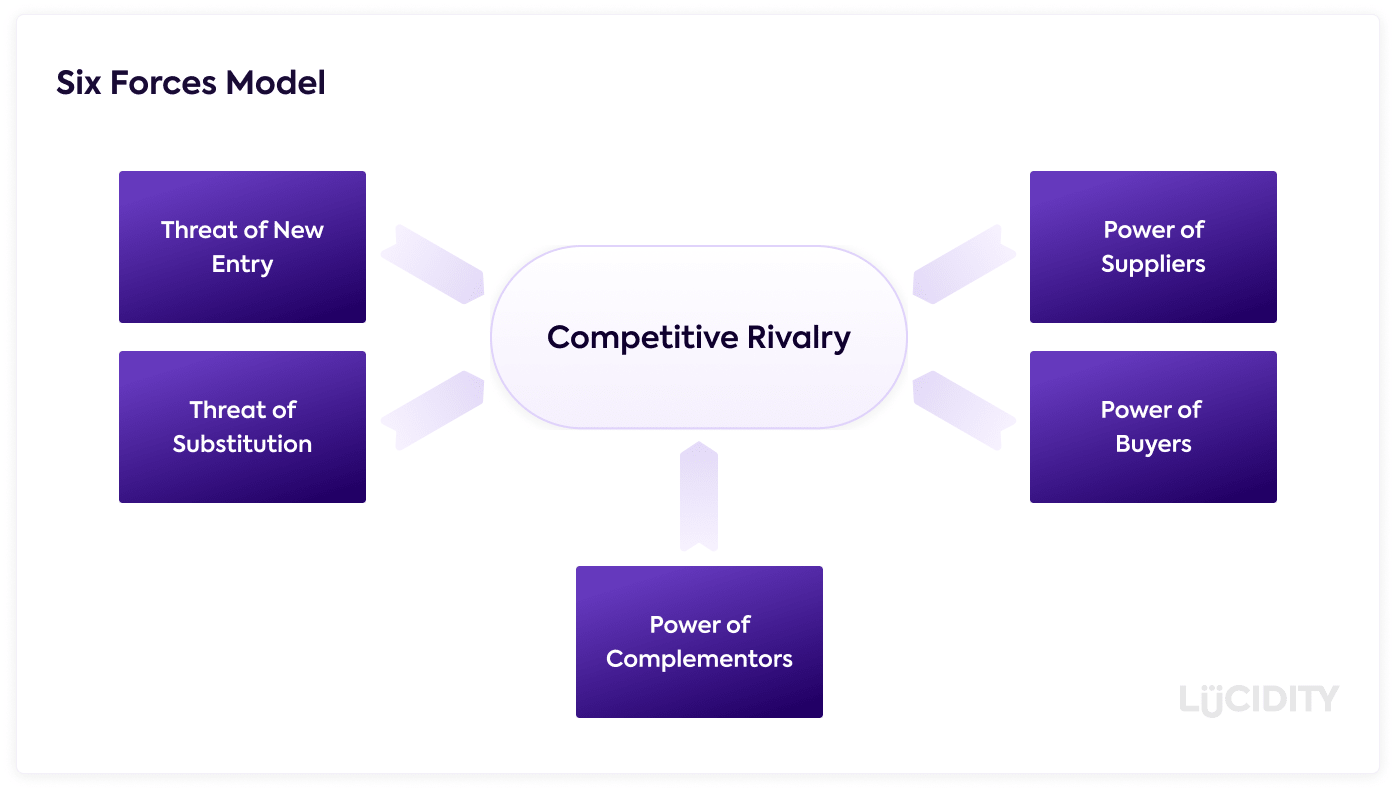Michael Porter developed [Five Forces](), one of the most popular business frameworks for analysing marketplaces. Less commonly known is a revision of this model that included Six Forces. We learn more…
What is the Six Forces Model?
The Six Forces Model is an extension of the Five Forces framework, and is used to analyse and understand the forces shaping your competitive marketplace and impacting your own strategic options. As with Five Forces, this model covers dynamics of the customers, the power of suppliers, the risk you’ll be substituted with a different product or service, the different direct competitors, the risk of new entry to the market and adds the force of complementary products.
What are the six forces in the Six Forces Model?
Five of the forces are the same as in the Five Forces model:
Power of Buyers:
This covers your customers and is a summary of their power to control your price point or overall direction. Factors include:
- Number of customers
- How significant they are in size
- Cost of customer acquisition
- Sales cycle length
- Relationships with customers
Power of Suppliers:
This covers any supplier you use in developing a product or providing a service, such as materials used when manufacturing or software used when servicing. Factors include:
- Number of suppliers in the market
- Options to change supplier
- Ease of change
- Relationship with suppliers
Risk of Substitutes:
This force looks at how easy it would be for your product or service to be replaced with an alternative. Factors include:
- Are there substitutes available?
- What would the cost to customers be to move?
- Are you seeing current customers migrate to substitutes?
Keep in mind this force is not about competitor products that are the same as yours, it’s about substation.
Risk of New Entrants:
The force of New Entrants examines how easy it is for new entratns to enter the market. Keep in mind:
- Time and cost to enter the market
- What tangible and intangible assets are required for success
- Are there companies that operate in parallel markets?
- How attractive is the marketplace?
This force isn’t just start-ups – large, established companies could move into your market too.
Competitive Rivalry:
This force is commonly discussed within companies as it looks at the existing competition to your product and service. Factors to consider when rating this force are:
- How many providers of your product or service are there?
- What is the differentiation between providers?
- What is your competitive advantage?
- How does the number of operators in the market impact price?
Your sales team would be helpful when identifying these forces.
Complementary Products:
This is the new one!
Complementary products and services can have a significant impact on your business, and this force examines that impact. For example, take a business that produces a case for Apple’s iPhone range. If Apple release an updated iPhone, these companies are likely to see an increase in the sales of iPhone cases. Conversely, if Apple see a decline in iPhone sales, then so will the accessory companies. Factors to consider:
- What products or services complement your business?
- What products or services do you complement?
- What is the customer opinion of these complementary products or services?
Complementary products are defined by Porter as products that offer more value together than apart.
What are the advantages of Six Forces Model?
The Six Forces Model has a number of advantages:
- It’s simple to understand and use
- It covers a lot of specific issues that directly relate to your growth
- It factors in complementary products, unlike Five Forces
- You can do it on your own, as a team in person, or as a group remotely
- It provides a better overview of your competition
What are some of the limitations of the Six Forces Model?
As with Five Forces, there are some limitations to Six Forces Model:
- There’s no analysis of your business, it’s purely external
- There are no actions out of this framework
- It’s a short term analysis where the information can rapidly change
- It’s a high level view on the marketplace
- There are no factors outside of the market being considered
- Products can have a great impact on your business without being strictly complementary
What preparation should be done before a Six Forces Model?
The Six Forces Model can be a really powerful way to analyse your environment if you ensure you prepare with the following:
- Prepare for the session by researching the latest news on competitors
- Defining the marketplace you intend to analyse
- Be equipped with the information of why previous customers have left you
- Understand how customers use your product or service
- Understand complementary products or services used by your customers
If you’ll be doing Six Forces Model in a group, remember to share this information in advance.
Who invented the Six Forces Model?
Andrew Grove is credited with adding a sixth force to the original Five Forces model.
What’s the best medium for running a Six Forces Model based session?
Six Forces Model is best developed as a group project. Due to the range of forces, the team who analyse the framework should be composed of senior sales, marketing or product individuals, generally who are outward looking and are aware of the latest market developments.
How often should we update our Six Forces Model?
Just like Five Forces, this model becomes out of date quicker than many other frameworks because it’s so reliant on what is happening externally and the activity of other businesses. It is best conducted whenever a market is being analysed for entry, investment or strategic decision making.














